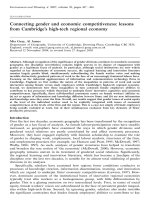gender stereotypes
Bạn đang xem bản rút gọn của tài liệu. Xem và tải ngay bản đầy đủ của tài liệu tại đây (33.35 KB, 3 trang )
Prof. Karen Hall
Teodor DimitrovAUB102
ID#019500040Gender StereotypesToday, every one
of us is spending more of his leisure time watching TV, listening to the
radio or reading newspapers and magazines. The shows on the TV and
the articles in the newspapers influence our decision process, shaping
our perceptions for the world. Besides the positive fact that we are better
informed and in touch with the latest news, we should be aware that
accepting this enormous flow of information and allowing it to make our
mind can be dangerous. The TVs infiltrate our lives, guiding us what are
we supposed to wear, how are we supposed to look and act. Children,
because of lack of mature judging values, are more susceptible to the
influence of the television. They tend to accept everything they see on TV
as real. Kids often identify with movie characters and comics figures
much more than the elder generation does. It is the role of the parents to
teach them that not everythink that glitters is gold and to give them a
better perception of the world. That of course does not mean that parents
are affected less by the TV. On the contrary, they are often more
affected than their kids, of course not by cartoons, but by shows that
contain information about serious subjects such as parenthood.
Concerned with being good parents, people are accumulating a lot of
information on the subject. As the information can be very helpful,
sometimes it can be destructive. That is the case when it comes to the
problem of "tomboys" and "sissies." What are these two terms used for?
The term "tomboy" is used when referring to a girl who is masculine, and
the term "sissy" is used when referring to a boy who is feminine. We need
to state what we consider feminine and what is masculine. According to
the established sense in the society, femininity and masculinity are tightly
bound to gender. Men are supposed to be masculine. They are expected
to be strong, rough, to have high stamina. They are not supposed to wear
skirts(the Scots are an exception) but trousers, and should avoid colors
like pink and violet. These are "feminine" colors. The man in the family is
usually the person who should provide money and build a career. On the
othere hand, women are supposed to be tender and loving mothers and
wives, to wear skirts and to walk on higheels. They are should not have a
career, but should take care of the kids and the house. It seems that
these perceptions have been existing forever. That is because from early
childhood, we are thought by our parents that pink is for girls, and blue is
for boys. The trucks and weaponry toys are for boys and the dolls are for
girls. Than, it is not surprising that we accept gender stereotyping and try
to fit in the rigid models of feminine and masculine. For example, women
athletes and especially tennis players and basketball players are afraid of
losing their femininity. These sports are famous for the large number of
gay players that are involved. Because of that, the hetero athletes are a
subject of suspicion of being gays. To avoid this they are trying to look
more feminine. A basketball coach even had developed a term for this
phenomenon "hetero-sexy." We are not only trying to fit in the models,
but we are prone to pass our perceptions to our children. In this way, we
are trying to protect them from the society. However by doing this, we are
causing them more harm than if they were to become gays. A recent
show on NBC Superchannel was dedicated to the problem of "tomboys"
and "sissies." In it, light was shed on the life of some tomboys and
sissies, as well as on the anxiety of their parents. A girl at an age of three
was shown, dressed with a skirt and playing with dolls. The next shot
was at an age of four, revealing the changes that the attitude of the girl
towards the dolls and dresses has been totally changed. Now she
preferred to hang out in jeans rather than in dress. When she was asked
by her mother to try a pink dress, she refused with the words "Pink
sucks!" The girl participated actively in sports such as basketball and
baseball, demonstrating good technical skills at both. Why then her
parents were worried and had searched psychological advice? The
answer to this question is in the assumption that when such kids grow up,
they inevitably will turn to be gay. The fear of the parents is raised by the
fact that their girls or boys ignore the existence of their gender and prefer
to communicate only with the opposite one. A girl on the show, when
asked about her friends, revealed that she hang out only with boys. Her
mother explained that, when she was introducing her to friends and
calling her "my little girl," the kid argued with her that she is in fact a boy
"You have two boys mom, not a boy and a girl, " she replied. The girl was
involved into a test the nature of which was to determine her affections
toward some pictures that were shown to her. From the results could be
inferred that the girl was prone to accept her as a boy and to accept boys
as her friends A recent show on NBC Superchannel was dedicated to the
problem of "tomboys" and "sissies." In it, light was shed on the life of
some of them, as well as on the anxiety of their parents. A girl at the age
of three was shown, dressed with a skirt and playing with dolls. The next
shot of her was at the age of four, revealing that the attitude of the girl
towards the dolls and dresses has been totally changed. Now she was
preferring to hang out in jeans rather that in a dress. When she was
asked by her mother to try a pink dress, she refused with the words "Pink
sucks!" The girl participated actively in sports such as basketball and
baseball, demonstrating good technical skills at both. She revealed that
all of her friends are boys. Her mother explained that when she was
introducing her to friends and calling her "my little girl," the kid argued
with her that she is in fact a boy. "You have two boys mom, not a boy and
a girl." This attitude of the girl did not appear to be normal for the parents
and that is what scared them. They were scared because they were not
pleased with the possibility of raising a gay. This underlines an important
tendency in our society. Most of the people are still uncomfortable with
gays. They tend to associate gays only with negative things such as AIDS
and other diseases. Gays are not allowed to serve in the army and to
occupy high decision-making positions. That's why, it is not surprising
that parents are concerned with the problem. They are trying to protect
their kids from the society, large portion of which does not tolerate
"deviations" from the established norms of behavior. The assumption that
when such kids grow up, they inevitably will be gay. This paranoia was
further expanded by studies which appeared to be dealing with the
problem. The results from them were striking, 25% of all "tomboys" will
inevitably be lesbian when they grow up, and 35% of the "sissies" will be
gay. The parents were trying to prevent that to happen by every mean.
Some of them even went extreme and oppressed their kids by using
punishment. However, as later was discovered, the studies were
conducted on extreme cases. For example, all of the participants in the
study on "sissies" were boys who not only played with dolls, but dressed
themselves as girls. Most of them were raised by single mothers and in
an environment where their contacts with men were limited. Recent
studies discovered that you do not become a gay, you are born one,
contrary to the assumption that sexuality is formed in the childhood. In
this case, the parent's desire to fit their children into the stereotypes
backfired and resulted in harming their children. The parents were a
victim also, by following the rigid path of stereotyping they wounded the
one that they love most their children.









